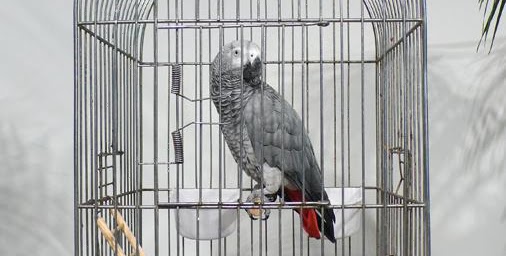Don’t Say I Didn’t Say So – The Parrot
 The Belgian conceptual artist Marcel Broodthaers once pondered about the question of how art contains meaning for its viewers. When looking at his fragile eggs installations one might wonder whether such meaningful art might be discovered beyond the spectacle of London’s renowned art fair.
The Belgian conceptual artist Marcel Broodthaers once pondered about the question of how art contains meaning for its viewers. When looking at his fragile eggs installations one might wonder whether such meaningful art might be discovered beyond the spectacle of London’s renowned art fair.
These art forms invite the viewer to take part in the construction of meaning so that one might suspect that they contain a high degree of meaning for the viewer when doing so. Given that these practices originated in the desire to create un-sellable art outside of any institutional contexts.
 The installation ‘Don’t Say I Didn’t Say So‘ is comprised of a caged African Grey Parrot, two palm trees, a vitrine containing his catalogue from a 1966 exhibition along with a reprint from 1974, and a recording of the artist reading the poem “Moi Je dis Je Moi Je dis Je…”
The installation ‘Don’t Say I Didn’t Say So‘ is comprised of a caged African Grey Parrot, two palm trees, a vitrine containing his catalogue from a 1966 exhibition along with a reprint from 1974, and a recording of the artist reading the poem “Moi Je dis Je Moi Je dis Je…”
It was created in 1974 as one of the earliest of Broodthaers’s retrospective installations. As art historian Rachel Haidu has noted in her work on Broodthaers, these series plays on the aspects of repetition and artificiality.
Haidu writes that the inclusion of a live parrot in “Ne dites pas…” emphasizes the notion of the retrospective as repetition: : “By highlighting the species of tropical bird famous for repeating itself as well as what others say, Broodthaers underscores, pathologizes and parodies the aspect of repetition intrinsic to the artistic retrospective.”
Marcel Broodthaers was working primarily as a poet until he decided to become an artist at age 40, and for the last twelve years of his life he made a richly varied, elusive, and influential ‘ouevre’ of work until he died in 1976. His associations in which he explores the nature and meaning of language, word, image, and rhetoric garnered him the most attention and fame, even though his work also encompasses poetry, writing, books, film, photography, slides, drawing, painting, and sculpture.
[widgetkit id=13341]
When he made his first artwork and symbolically ended his literary career, he embedded 50 copies of his latest book in a lump of plaster. He unleashed himself on the art world with a provocative statement: “I, too, wondered if I could not sell something and succeed in life. . . . The idea of inventing something insincere finally crossed my mind, and I set to work at once.” Broodthaers may have been the world’s most sincere maker of “insincere” artworks.
Film was an important part of Broodthaers’ artistic activity, spanning almost twenty years and numerous projects, and it predated his career as a visual artist. One of the most important manifestations of his film work is that Broodthaers raised questions that have since influenced successive generations of artists: about the very nature of art, its institutions, and traditions of classification within the museum structure. In today’s terms, Broodthaers was also a conceptualist who prized ideas more than finished products. His idea was to question the meaning, function and value of art, particularly in a museum context. Broodthaers seems to have been obsessed by the role of museums and how their methods of organizing and presenting art influence our perceptions of it. Like many modern and post-modern artists who adopt a skeptical stance toward tradition and accepted ways of doing business, Broodthaers bit the hand that fed him – and continues to be rewarded for doing so. This may appear to be an odd turn of events but, in fact, it seems as though no group loves to see its institutions ridiculed more than the art crowd, particularly when the criticism is housed inside one of its sanctified palaces.

He was a relentless questioner who turned traditional museum practices upside-down. One of his methods was to invent his own museums and install them in his home or other buildings. His first one was nothing more than a batch of shipping crates, postcards of 19th-Century paintings and a slide projection in his studio. For subsequent sections of his ambitious “Museum of Modern Art, Department of Eagles,” he concocted displays of reproductions, borrowed actual artworks, drew a museum plan on the beach and assembled more than 300 representations of eagles.
In one of his movies with the title “Interview with a Cat” from 1970 Broodthaers asks a cat what it thinks about certain paintings of the 20th century, realting back to his notion of sincerity and insincerity with the cat answering with a steady meow to the last question if something is indeed a pipe or not:
Several paintings, constructions and an installation are on view at Gallery Michael Werner, London, through Nov. 13, providing a perfect dialogue with Broodthaers’s one-of-a-kind Section Cinéma and shedding light on his many other activities.
One of his manifestations regarding the artist and the museum was also featured in the Agent Artist exhibition at the PS1 museum New York City 1994.

